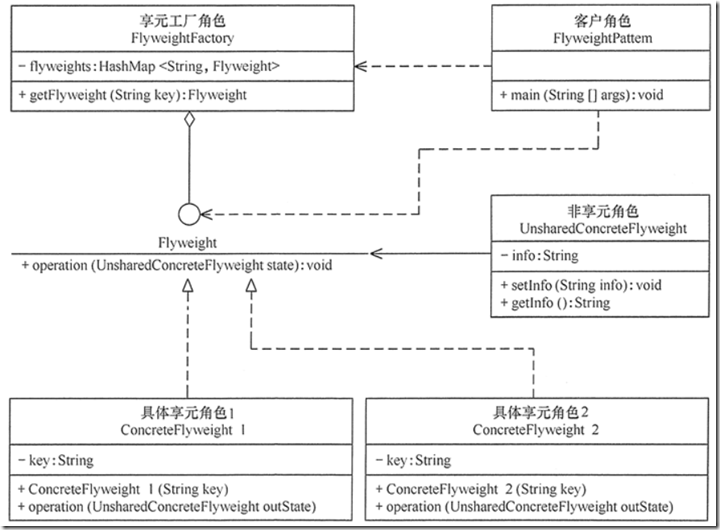本质:
- 缓存共享对象,降低内存消耗
什么时候用:
- 系统中存在大量相同或相似的对象,这些对象耗费大量的内存资源。
- 大部分的对象可以按照内部状态进行分组,且可将不同部分外部化,这样每一个组只需保存一个内部状态。
- 由于享元模式需要额外维护一个保存享元的数据结构,所以应当在有足够多的享元实例时才值得使用享元模式。
主要角色:
- 抽象享元角色(Flyweight):是所有的具体享元类的基类,为具体享元规范需要实现的公共接口,非享元的外部状态以参数的形式通过方法传入。
- 具体享元(Concrete Flyweight)角色:实现抽象享元角色中所规定的接口。
- 非享元(Unsharable Flyweight)角色:是不可以共享的外部状态,它以参数的形式注入具体享元的相关方法中。
- 享元工厂(Flyweight Factory)角色:负责创建和管理享元角色。当客户对象请求一个享元对象时,享元工厂检査系统中是否存在符合要求的享元对象,如果存在则提供给客户;如果不存在的话,则创建一个新的享元对象。
结构图:
示例代码:
public class FlyweightPattern { public static void main(String[] args) { FlyweightFactory factory = new FlyweightFactory(); Flyweight f01 = factory.getFlyweight("a"); Flyweight f02 = factory.getFlyweight("a"); Flyweight f03 = factory.getFlyweight("a"); Flyweight f11 = factory.getFlyweight("b"); Flyweight f12 = factory.getFlyweight("b"); f01.operation(new UnsharedConcreteFlyweight("第1次调用a。")); f02.operation(new UnsharedConcreteFlyweight("第2次调用a。")); f03.operation(new UnsharedConcreteFlyweight("第3次调用a。")); f11.operation(new UnsharedConcreteFlyweight("第1次调用b。")); f12.operation(new UnsharedConcreteFlyweight("第2次调用b。")); } } //非享元角色 class UnsharedConcreteFlyweight { private String info; UnsharedConcreteFlyweight(String info) { this.info = info; } public String getInfo() { return info; } public void setInfo(String info) { this.info = info; } } //抽象享元角色 interface Flyweight { public void operation(UnsharedConcreteFlyweight state); } //具体享元角色 class ConcreteFlyweight implements Flyweight { private String key; ConcreteFlyweight(String key) { this.key = key; System.out.println("具体享元" + key + "被创建!"); } public void operation(UnsharedConcreteFlyweight outState) { System.out.print("具体享元" + key + "被调用,"); System.out.println("非享元信息是:" + outState.getInfo()); } } //享元工厂角色 class FlyweightFactory { private HashMap<String, Flyweight> flyweights = new HashMap<String, Flyweight>(); public Flyweight getFlyweight(String key) { Flyweight flyweight = (Flyweight) flyweights.get(key); if (flyweight != null) { System.out.println("具体享元" + key + "已经存在,被成功获取!"); } else { flyweight = new ConcreteFlyweight(key); flyweights.put(key, flyweight); } return flyweight; } }
